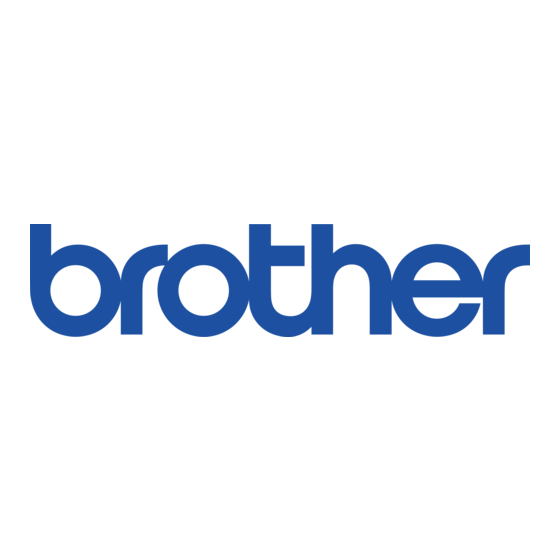

Brother PR-620 Tips And Techniques
Hide thumbs
Also See for PR-620:
- Operation manual (237 pages) ,
- Manual del instrucción (237 pages) ,
- Quick reference manual (28 pages)
Advertisement
Quick Links
Tips and Techniques on the PR-620
Techniques and Tips on the PR-620
Learn how to demonstrate the PR-620 and make it look as
easy as it really is. Topics to be covered will be: basic
operation, machine threading, screen icons, merging
patterns, using more than 6 colors in a single project and
much more. Be impressed at how swiftly you can transfer
designs from Brothers extensive library of cards or from the
computer/PE Design 8.0 software to the PR-620. Create
endless possibilities with the editing and copy function built
right into the machine.
Advertisement

Summary of Contents for Brother PR-620
- Page 1 Tips and Techniques on the PR-620 Techniques and Tips on the PR-620 Learn how to demonstrate the PR-620 and make it look as easy as it really is. Topics to be covered will be: basic operation, machine threading, screen icons, merging patterns, using more than 6 colors in a single project and much more.
- Page 2 Tips and Techniques on the PR-620 Machine Parts Front View: 1. Thread tension knobs 2. Thread pin guide 3. Needle bar case 4. Carriage 5. Hook cover/hook 6. Thread guide assembly support 7. Spool stand 8. Operation panel 9. Feet Side view: 1.
- Page 3 Tips and Techniques on the PR-620 Opening screen 1. Settings key 2. Machine operations key 3. New Embroidery key 4. Help key 5. Pattern Display area Threading the bobbin and inserting the bobbin case into the hook 1. Insert the bobbin into the bobbin case 2.
- Page 4 Tips and Techniques on the PR-620 Threading the machine The numbers indicate the thread path for each of the numbered needle bars. 1. Place on spool pin 1 the spool of the thread with the color specified for the needle bar 1 2.
- Page 5 Tips and Techniques on the PR-620 5. Use the included threader to pass the thread through the number 1 needle bar thread guide. 6. Repeat this process for each needle to be threaded. Threading the needle Note: A design should be loaded in order to thread the needles.
- Page 6 Tips and Techniques on the PR-620 Hooping the fabric in the embroidery frame Select an embroidery hoop to use. Be sure to use an appropriate size frame for the size of embroidery that you will be doing. If the embroidery frame that is used is too large, the pattern may be misaligned or the fabric may pucker.
- Page 7 Tips and Techniques on the PR-620 6.Using the disk shaped screwdriver, firmly tighten the screw. Check the embroidery area 1. Touch , a message appears warning that the embroidery frame is about to move, select 2. Touch again. The corners of the octagon showing the embroidery area for the pattern are indicated by needle punch points.
- Page 8 Tips and Techniques on the PR-620 4. Display the embroidery screen, and then touch the key for any needle bar other than the one that is locked and the needle bar will unlock. To transfer a design from the computer using the USB cable included with the machine 1.
- Page 9 Tips and Techniques on the PR-620 To transfer a design from a USB device (purchased separately) to the machine 1. With the front of USB drive facing towards you, fully insert the stick into the right side of the operation panel.
- Page 10 Tips and Techniques on the PR-620 Selecting an Embroidery Pattern and merging letters Vario us patterns, such as embroidery patterns, frame patterns, built in designs and patterns on embroidery cards, can be easily combined. To merge designs, select Built in designs on the operation panel.
- Page 11 Tips and Techniques on the PR-620 Create a repeating pattern The entire pattern can be copied and repeated the specified number of times. The pattern can be repeated a maximum of 30 times in both vertical and horizontal directions with in the embroidery area.
- Page 12 Tips and Techniques on the PR-620 Changing colors of a pattern 1. In the Operation panel, select , the letter R 2. Touch . The thread change color screen appears. The part of the pattern in the color at the top of the thread color...
- Page 13 Tips and Techniques on the PR-620 Specify pause locations before embroidering 1. Pause locations can be specified in the thread color change screen. 2. Touch in the pattern editing screen or the embroidery settings screen. 3. Touch so that the color at the top of the thread color sequence display is the color where you wish to stop the machine before sewing it.
- Page 14 Tips and Techniques on the PR-620 Setting a lock stitch between each color Lock stitches can be sewn at the beginning of the pattern, the beginning of sewing each thread color change and at the beginning of sewing after the thread trim.
- Page 15 Tips and Techniques on the PR-620 Tips and hints for the PR620 1. You must place the hoop on the machine, turn on the machine and then select your design for proper centering within the desired hoop. If you choose to "resume" a design with a different size hoop, it will not be centered correctly.











